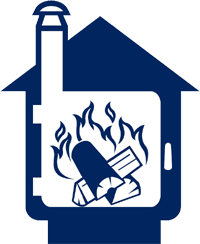Is Your Chimney Up To Snuff?
 Burn it Smart... In the RDN
Burn it Smart... In the RDNIs Your Chimney 'Up To Snuff'?
[3 of 4 in the series]
When was the last time you had your chimney properly examined? Other than sweeping it once a year many people don't give much thought to their chimneys, especially to what is happening inside it.
When your woodstove fire is burned hot, mainly water and carbon dioxide are emitted from your chimney. With an inefficient fire, you can actually see and smell the unsafe wood smoke outside. But unseen inside the system, where any smoke leaving the woodstove flows up into the relatively cooler chimney, condensation will occur.
The resulting residue that sticks to the chimney's inner walls is creosote, which is black or brown in appearance. It can be crusty and flaky, tar-like, drippy and sticky, or shiny and hardened. Often, all forms will occur in one chimney system.
Whatever form it takes, creosote is highly combustible. If it builds up in sufficient quantities - and catches fire inside the chimney flue - the result will be a chimney fire. To ensure your chimney is "up to snuff", have it checked regularly by a Wood Energy Technical Training (WETT) certified chimney sweep. Those certified professionals have passed a rigorous training program recognized by industry and government.
"WETT certified chimney sweeps are able to keep abreast of changes in codes, installation materials, and techniques through WETT's continuing education program," says Zigi Gadomski, "Burn it Smart" committee member and President of the Wood Energy Technicians British Columbia. "Two of the most important things they learn are proper venting principles, and the clearances required for chimney and hearth products."
Ensuring the efficiency of your chimney is paramount to providing the draft, which is the main driving force of the system. Without good, strong draft, many stoves fail to operate at their peak efficiencies. Produced in the chimney by hot rising gases, draft causes a negative pressure or suction to develop in the firebox. This draws more air in allowing the fire to continue burning.
Woodstoves depend on the draft generated by a hot chimney to safely exhaust gases resulting from the burning wood. Interior chimneys are highly recommended as they are always warm, so the draft is better and creosote problems are less likely to occur.
Emergency Services | 6300 Hammond Bay Road | Nanaimo, BC V9T 6N2 | E-mail: [email protected]
Telephone: 250-390-4111 (Nanaimo) 1-877-607-4111 (Toll Free) | 250-390-2757 (Fax)
